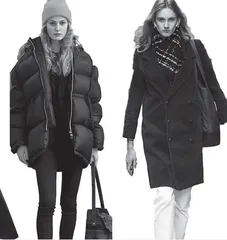Layered Clothing 洋葱式分层穿衣法

As a bout of bitter and deadly cold sweeps the earth, millions of people are being told to dress in layers if they must go outside.
一场致命的严寒席卷大地,数百万人被告知,若必须外出,就要穿多层衣服。
What Is Layering?
什么是洋葱式分层穿衣法?
Layering means wearing multiple pieces of clothing to keep your body comfortable in cold weather. Each layer creates an insulating pocket of air that protects you better than just wearing a big jacket, and layering helps move sweat and moisture away from your skin.
No matter how cold it is, you’re probably going to sweat when you go outside and start moving.If you’re wearing the correct layers, you can feel perspiration wick away from your body. The idea is to add another layer if you get cold, or take off a layer when you get hot or wet.
洋葱式分层穿衣法是指穿多件衣服,以便在寒冷的天气让身体舒适。每一层衣物都会形成一个隔热的空气袋,比只穿一件大夹克更能提供保护,而且分层穿衣法有助于带走皮肤上的汗水与湿气。
无论天气有多冷,你到户外开始活动时,就可能会出汗。如果你穿的衣服有正确分层,就会感觉到身上的汗水消失。如果你觉得冷,就再加一件;若觉得热或汗湿了,就脱掉一件。
Avoid Cotton and Wetness
避免棉质衣物与潮湿
Just look for things that aren’t cotton.
Cotton absorbs moisture, so it stays wet longer. Cotton socks can get wet in your boots or shoes if you walk in the snow, and a cotton shirt under your jacket can get wet with sweat. Cotton won’t dry quickly, so you’ll get colder.
Instead, choose wool socks and fabrics made of fleece, polyester or polypropylene. You can also repurpose old vests and shirts, which are great at keeping your core warm. Many of these items might also already be in your closet; layering up doesn’t have to cost a fortune.
只要找非棉质的衣物就行。
棉布会吸收水分,因此潮湿的时间会更久。如果在雪中行走,靴子或鞋子里的棉袜可能会弄湿,夹克里的棉质衬衫可能会被汗水浸湿。棉不是快干的材质,所以你会觉得更冷。
相反地,应选羊毛袜,以及羊毛、聚酯或聚丙烯纤维材质的布料。也可以把旧背心和衬衫再拿出来穿,它们对身体核心的保暖很有用。你的衣柜里可能已经有这些衣物了,洋葱式分层穿衣法并不需要花大钱。
Think of Three Main Layers
洋葱式分层穿衣以三层为主
To start with a base layer, then a mid layer and then an outer layer.
The base layer is closest to your skin, so it’s important for the fabric to wick away moisture. Choose polyester over cotton for this. Then, wear a mid layer—a vest or a shirt—to keep your core warm. Some people choose to wear more than one mid layer. Finally, wear a traditional winter jacket that breaks the wind a little but also insulates you.
从里层开始,然后是中间层,再来是外层。
里层最接近皮肤,因此布料将湿气吸走排出很重要。为此,请选择聚酯纤维而非棉质的衣服。然后穿上中间层——背心或衬衫——以保持身体核心温暖。有些人的中间层不只穿一件。最后,穿一件传统的冬季夹克,既可防风,又能隔热。
Dress to Prevent Frostbite
预防冻伤的穿衣法
Frostbite—a painful injury in which skin freezes, blood flow decreases and tissue gets damaged—can happen within minutes in cold weather when skin is not adequately covered. Symptoms include blistering of the skin because it’s damaged, along with bruising and swelling. Frostbite can even result in the loss of a limb, if it’s not properly treated.
Layering up can prevent frostbite because it traps a bit of insulating air between each layer of fabric. It’s more effective than simply wearing a big coat because layers “tend to keep the moisture from outside—or the moisture from your body—from traveling as far as it gets trapped” by the air within each layer.
冻伤是一种皮肤发凉、血流减少和组织受损的痛苦伤害——在寒冷天气中,当皮肤没有包裹完好,几分钟内就会发生冻伤。其症状包括皮肤因受损而起水泡,以及瘀伤和肿胀。如果不进行适当治疗,冻伤甚至会造成截肢。
洋葱式分层穿衣法能防止冻伤,因为它可以在每层布料之间保留一点绝缘的空气。它比只穿一件大衣更有效,因为每层衣物间的空气只要进来了,“往往就会阻隔外部的水分或身上的水分进出”。
Word Bank
moisture /'mɔɪstʃə(r)/ n. 潮气;水汽;水分
fleece /fliːs/ n. 羊毛;(一只羊一次剪下的)毛
adequately /'ædɪkwətli/ adv. 足够地;合格地;合乎需要地
Are you adequately insured?